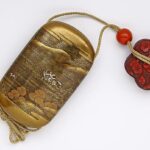TANIHOJO Personal History
Tani Kanjyo was a retainer of Yamauchi Yodo and served as his close aide. He was told by Shintaro Nakaoka, who was still alive at the scene of the assassination of Ryoma Sakamoto and Shintaro Nakaoka, that the incident was the work of the Shinsengumi.
Tani vows to take revenge after hearing that the Shinsengumi was responsible for the assassination. Tani vowed to take revenge. After Isamu Kondo captured Ryoma in Nagareyama, Tani interrogated him thoroughly and beheaded him, but he was not allowed to commit seppuku as a samurai.
It is said that he did not allow him to commit seppuku as a samurai. Yamauchi Yodo ordered Takeichi Hanpeita to commit seppuku because of his support for the expulsion of the Emperor.
ANI TANITAKI February 12, 1837 (March 18, 1837) May 13, 1911 (Meiji 44) Tosa Clan samurai, army soldier, politician.
Rank: Lieutenant General of the Army, 1st Viscount Kaoru.
As a member of the Imperialist faction of the Tosa Clan, he served as one arm of Taisuke Itagaki and concluded a secret agreement with the Satsuma Clan, Takamori Saigo, and Taito Komatsu to defeat the shogunate in Satsudo.
During the Boshin War, he was a military commander who fought on the front lines and showed his military prowess as a commander of the government forces in the Battle of Kumamoto Castle during the Nishiman War.
He further distinguished himself as a military commander in the Battle of Kumamoto Castle during the Nishiman War.
Born on February 12, 1837 (March 18, 1837) in Kubokawa, Takaoka-gun, Tosa Province as the fourth son of Tani Kagei, a Confucian scholar in the service of the Tosa Clan. (He was born in Kubokawa, Takaoka Gun, Tosa Province.
He also became acquainted with Takeichi Hanpeita, and became a devoted follower of the Emperor and expulsion of the barbarians. While traveling back and forth between Edo and Nagasaki, he met the former feudal lord Yodo Yamauchi.
When Takeichi was ousted from his post, Tani was left in the first year of the Genji era, and he remained quiet until he was reinstated at Shidokan in the first year of the Keio era (1868).
He remained quiet until he was reinstated at the Shidokan in 1868. However, his view of foreigners changed, and he was told by them that expelling the barbarians was impossible.
He was soon to travel by ship to Shanghai, where he witnessed the military might of the West, and became a supporter of Goto's views on opening the country to the outside world and overthrowing the shogunate.
On May 21, Keio 3, he was introduced by Shintaro Nakaoka, and together with Taisuke Itagaki and Yoshimori Mori, he concluded a secret agreement with Satsuma in Kyoto, aiming at an armed defeat of the shogunate.
However, Goto's idea was different from Tani's, as he wanted to defeat the shogunate peacefully with the aim of restoring the "Daisei Hokan" (the return of the Grand Council of State).
When the Boshin War broke out in 1868, Goto and Itagaki joined forces to fight in the war.
He played an active role in the battle, and his family stipend was increased to 400 koku and he was appointed as an officer in charge.
In the 2nd year of Meiji, he was promoted to the position of junior councilor for three years. He was opposed to the opinions of Goto and Itagaki, but he gained the trust of the opponents and at the request of the clan, which could not ignore his opposition, he was reinstated as a minor counselor in the 4th year of Meiji and worked to reform the military policy of the clan's soldiers.
After the abolition of the feudal domain in July of the 4th year of Meiji, he served in the new government as a "Hyobu Gon Taisho" and in 1872, he was transferred to the post of Chief Judge of the Army and appointed as a Major General of the Army.
In the following year, in 1872, he was transferred to the post of Chief Judge Advocate General of the Army and appointed Major General of the Army.
In 1878, he was promoted to lieutenant general of the army for his distinguished service in the Civil War.
His victory in the Civil War earned him the trust of the Emperor Meiji, and the military took notice of him.
For this achievement, he was appointed Director of the Military Academy in 1878 and Director of the Army Toyama School.
In May of 1884, he was reinstated as Director of the Gakushuin (Gakushuin Academy), a post to which the government had requested him to return. Hearing Ito Hirobumi's request for reform
The Hanafu promoted the education of their children and formed independent education in the Diet, the Hanafu Youth Association, and the Hanafu Douhoukikai.
Tani soon became fully involved in earnest.
After returning to Japan, he became a politician who emphasized national autonomy through the Diet.
He died in 1911 at the age of 75.





